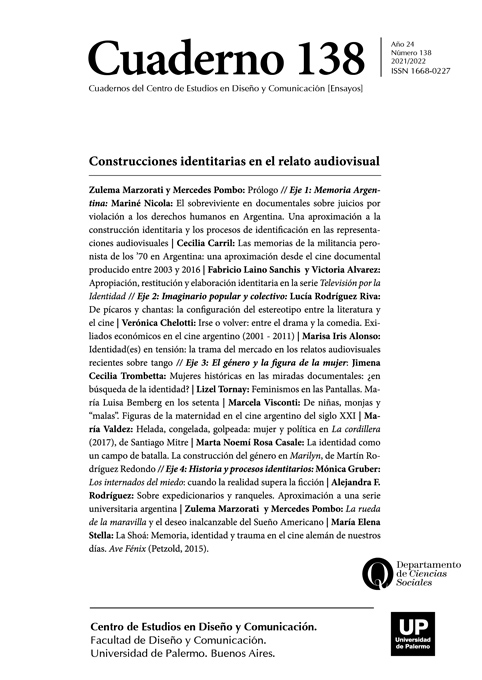La Shoá: Memoria, identidad y trauma en el cine alemán de nuestros días. Ave Fénix (Petzold, 2015)
Abstract
The memory of the Shoah has followed a diachronic evolution of enormous magnitude. Indeed, from the misunderstanding and concealment of the event, in the immediate postwar period, it has become, in our days, the “civil religion of the West”, according to Enzo Traverso (2011). This becoming is not disconnected from the new regime of historicity - the way a society relates to the temporal triad past, present and future - that affects politics and culture in the age of globalization. For four decades, with the collapse of the idea of progress that Modernity sustained, the future lost its priority and guiding character and its place became occupied by the past, but not by a past from which it is possible to draw useful lessons. but rather a history full of genocides, wars, human rights violations, that is, a past that should be permanently remembered so that it does not repeat itself. A past, necessary, always present that prescribes the duty of memory. The centrality of the violent past favored the incorporation of the category of trauma, which, imported from the field of psychoanalysis and the phenomena that influence the individual psyche, served to explain the acts of violence that affected large human groups. In this way, the traumatic event, the denial, the amnesia, the anamnesis and the return of the repressed were incorporated into the semantic field of the mass massacres of the 20th and 21st centuries, leaving said explanatory potential to history and social memory. (Rousso, 2015) he traumatic event -individual or collective- affects the construction of identity, exceeds the known frames of reference necessary for the narrative, breaks the causal chains with which people or groups elaborate the trauma. The fall of the Berlin Wall, the following German reunification led to the process of elaboration of the violent past and the construction of a new pluralistic, democratic German identity, which takes over, judges and condemns the national socialist past. The convergent processes, previously described, the different stages of the memory of the Shoah, the elaboration of the trauma and the construction of new group and individual identities are represented, among other audiovisual productions, but in a paradigmatic way in the film Ave Fenix, Directed by Christian Petzold, (2015), whose filmic analysis, images, discourses, its historical, social and cinematographic context will be dealt with in this article. Based on the novel by the French writer Hubert Monteilhet, Le retour des cendres, published in the early 1960s, Ave Fenix, is set in Germany in 1945 and narrates the return of a survivor from the Nazi concentration camps, a theme that According to the director, he had been eluded by German cinema and whose memory he deemed necessary to restore. The former prisoner returns from the horror, she not only with the trauma of the extreme experience lived, but with her face disfigured by a machine gun shot. The search for an elusive explanation, the difficulty of narrating what happened, the reconstruction of her identity and her face constitute the metaphor of collective trauma, the attempt to understand and elaborate the Holocaust.
References
Deleuze, G. (2005) La imagen movimiento Estudios sobre cine 1. Buenos Aires, Paidós.
Fulbrook, Mary (1995) Historia de Alemania, Cambridge, Cambridge University Press, Traducción española Beatriz García Ríos.
LaCapra, D (2005) Escribir la historia, escribir el trauma. Buenos Aires, Nueva Visión.
Loriga, S. (2018) Sobre el trauma histórico, Pasajes. Revista del pensamiento contemporáneo. Número 54 pp 92-110. En: https://www.academia.edu/38310490/T (Consultado 10 de enero de 2021)
Pollak, M (2006) Memoria, Silencio. Olvido. La producción social de identidades frente a situaciones límite. La Plata, Ediciones Al Margen.
Rees, L. (2005). Auschwitz Los nazis y la ‘Solución final’. Barcelona. Crítica.
Romeyke,S.(2016) La justicia transicional en Alemania después de1945 y después de 1989, Academia Internacional de losPrincipiosde Núremberg. En: https://www.nurembergacademy.org/fileadmin/media/pdf/publications/Justicia_transicional_en_Alemania.pdf (Consultado el 10 de Diciembre de 2020)
Stella, M (2018) “Holocausto, Memoria y justicia. Representaciones en el cine alemán de nuestros días” en Actas del VI Congreso Internacional de ASAECA. En: http://asaeca.org/wp-content/uploads/2017/11/Libro-de-actas-AsAECA-2018-2-1.pdf (consultado 12 de febrero de 2021).
Stella, M. (2019) “Holocausto y memoria en los tiempos de la globalización. Representaciones en el cine alemán” en Cine e Historia. Representaciones fílmica en un mundo globalizado. Centro de Estudios en Diseño y Comunicación. Universidad de Palermo, Cuaderno Número 77, Año 20.
Traverso, E. (2011), El pasado, instrucciones de uso, Buenos Aires, Prometeo.
Los autores/as que publiquen en esta revista ceden los derechos de autor y de publicación a "Cuadernos del Centro de Estudios de Diseño y Comunicación", Aceptando el registro de su trabajo bajo una licencia de atribución de Creative Commons, que permite a terceros utilizar lo publicado siempre que de el crédito pertinente a los autores y a esta revista.


